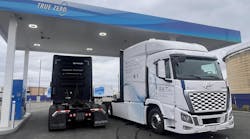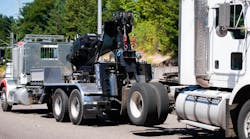Last April, Magnum, Ltd.'s truckload division installed telematics gear on most of its 155-truck fleet and the results have been astounding. Just prior to working with PeopleNet Communications, the company had 10 dispatchers who handled about 600 calls during a heavy day. Now, they've reduced the call volume to 150 calls from drivers and customers, and dropped their dispatching staff to eight people.
“We're still figuring the return on investment (ROI),” says Jade Nelson, fleet operations manager for the Fargo, ND, fleet, “but we know already that our phone expenses are down a lot.”
The savings came from doing away with most of the fleet's call-in routines. For example, drivers used to call in to report their locations between 7 a.m. and 10 a.m. Now, GPS locates the drivers at 6 a.m., then again at 10 a.m. and 2 p.m. automatically. “What used to take 10 to 15 minutes of a dispatcher's and driver's time, now takes 30 to 45 seconds,” Nelson says.
The big change for the company is that they now “manage by exception,” he notes. They don't need to know if a driver is doing something right or that all data keyed to his load is okay; they only want to know if his location or some other piece of logistical information is wrong. Only then do dispatchers take action. That's a huge savings, says Nelson.
In many ways, Magnum's experience is typical of fleets that want to embrace telematics but are going slowly, starting with location and communications services and migrating toward receiving and analyzing more data, including remote diagnostics. Buoyed by the excellent ROIs from simple applications and a gradual buy-in from staff and management, commercial telematics is starting to take off — albeit more slowly than predicted.
“Telematics was born in the heyday of the Internet bubble,” says Egil Juliussen, principal analyst at Telematics Research Group, Chicago. He says that telematics has to work off some of the hype of the past few years; it probably won't take off like a rocket the way some must-have applications do when they're introduced.
“There is no killer app (application) in telematics,” says Juliussen. “Commercial telematics will grow because the ROI is easy to see. Long term it pays for itself — there's no doubt about it. But industry growth will be incremental as we set up the infrastructure and learn how to analyze and use the data.”
According to a forecast by Boston-based Strategy Analytics, the North American market for commercial telematics shows growth of about 3% annually until 2006, based on the number of units to be shipped and installed. “There was huge hype two years ago that didn't pan out,” says Mark Fitzgerald, senior industry analyst for the research firm's Automotive Electronics and Telematics Practice.
Commercial and personal drivers in Germany are starting to use real-time traffic alerts, which gather information from specially installed transmitters on cars and trucks as they pass designated checkpoints. Sensors collect data to determine how fast traffic is moving and sends it to other drivers so they can change their routes. “It's expensive to install this type of traffic information service, but users say it's even more expensive to sit in stopped traffic,” says Fitzgerald.
One of the stumbling blocks of such a “floating vehicle system” in the U.S. is who will pay for it — the public or private sector? “Another issue is that different parts of the country have different traffic data needs,” says Frank Viquez, director of automotive electronics for Allied Business Intelligence, Oyster Bay, NY. “A nationwide network probably would be tough to sell.”
Viquez adds that the commercial market thought personal telematics would spill over to its sector and help spur growth. But with the exception of a few applications, it didn't happen that way. For the most part, the commercial and personal sector will grow separately and run parallel to each other,” he says. If anything, services like remote diagnostics will move from the commercial to private sectors. For the commercial sector, the bottom line is still the ROI; personal telematics is often based on discretionary or luxury spending.
Estimates range far and wide for telematics ROI because each application and fleet is different. Brian McLaughlin, PeopleNet's director of marketing, says that for a 100-truck private fleet, his company estimates a cost of $76 per month, per vehicle ($29 in leased equipment, $47 service), yielding a savings of $161 per month, or an ROI of 89% in about three to six months.
Dave Ladner, PeopleNet's executive vp and founder, says the company's strength lies in selling services a la carte to companies and creating applications “that bring in hard dollar returns.” He notes that companies start with simple locating and communications services and expand when they're ready. About 20% of the 850 fleets he does business with use the fuel tax reporting service and 70% use some engine monitoring services.
With the largest share of the wireless market in trucking, QUALCOMM estimates similar ROI scenarios for its two major services — OmniTRACS for the longhaul, truckload market, and OmniExpress for regional operations.
The third major player in commercial vehicle telematics, Aether Systems, has also moved aggressively in recent years to acquire or develop new wireless services and networks to extend favorable cost-to-benefits ratios to a variety of fleet applications.
If the returns are so good, what's holding up rapid growth of commercial telematics in North America?
For one thing, North America has many different cellphone companies, some of which have incompatible networks. As the cellphone network in the U.S. becomes mature, and cellphone use among consumers levels off, telecom carriers will seek to fill their networks with more commercial data. Thus potential lower prices could entice many telematics companies to exploit the cellphone network even further.
To hedge their bets, some telematics companies like Snap-On, which bought bankrupt NEXIQ last year, hope to piggyback onto any telecommunications system — satellite or land-based. “We want to be wireless agnostic,” says Jamie Sura, vp-telematics at NEXIQ. Sura says the company's “e-technician” product can gather as much as 600 parameters of diagnostic data from a truck.
The company wants to focus on remote diagnostics and compete based on service and a lower price point than others.
Another issue that needs to be ironed out is the data infrastructure itself. Companies like IBM are pushing for open standards. “It offers a broad array of designers,” says K. Phillipps Dane, business development executive.
The company has partnered with Vetronix Corp., to take its existing diagnostics tools “out of the bay” and into the field, says Dane. “We're trying to demonstrate that the ROI model for telematics is strong, but the stumbling blocks are a lack of awareness among fleets and a poor economy.”
NEW SKILLS NEEDED IN-HOUSE
Another factor that may keep fleets from taking advantage of this technology is the need to have people on staff with the skills to handle it. Magnum's Nelson says that his company waited until they found the right people before installing their systems. He adds that getting drivers to embrace the new technology was a particular challenge. “But now I don't think they could imagine life without it.
Dane believes successful telematics systems will end up having an “off-board” approach, where the lion's share of data processing happens at the back end and not in the truck itself. He agrees with others that a web-based approach, rather than a proprietary one, may be the winning platform in the future.
Some in the telematics world hope that increased interest in homeland security will give the sector a jump-start. Hazmat carriers and fleets handling government contracts might be more interested in telematics for security reasons. For others, the link is more tenuous.
“We are not seeing a dramatic shift to telematics except in the area of homeland security, and these could have commercial applications,” says Fred Daly, assistant vp for legislative and regulatory affairs at the Intelligent Transportation Society of America.
He notes that there's a big push to merge short-range technologies like RFID with long-range options such as land- and satellite-based networks. But it hasn't been easy.
One plan calls for trucks to carry transponders similar to those in airplanes, but with shorter range. If a truck nears a critical landmark like a government building or nuclear power plant, the site will “ping” the truck, which should respond with an authorization code.
Data sent by the truck will come from a remote dispatcher. If the dispatcher does not respond properly, law enforcement will be alerted and swoop down on the vehicle before it gets closer. Another scenario has the truck being disabled by a remote signal. In the commercial sector, this kind of proximity alert system could have boundless applications for trucks delivering goods to warehouses, ports and rail yards.
“There's no one thing that's going to move telematics quickly,” says IBM's Dane. With a poor economy and margins in the trucking industry traditionally low, many fleets are still reluctant to spend money on telematics. “Often the question is, ‘who's going to take the first step?’”
Tell me about telematics…‥
In the beginning, trucking embraced “wireless data communications,” which largely meant two-way text messaging with a little bit of location data thrown in the mix. Telematics was a consumer product that was going to deliver navigation and security services to every driver on the road.
In the last five years, the differences between the commercial-market and consumer-market wireless products have blurred considerably as fleets began placing more emphasis on data and less on messaging. Also, consumers have shown a stubborn lack of interest in paying for telematics services, while trucking continues to provide a healthy vertical market for such services.
As a result, communications industry observers are attempting to breathe new life into the telematics concept by coining the term “commercial vehicle telematics” to describe trucking's old wireless data communications, as well as enhanced or second-generation versions of those services. So, that's why you're hearing more about telematics and less about wireless data these days.


